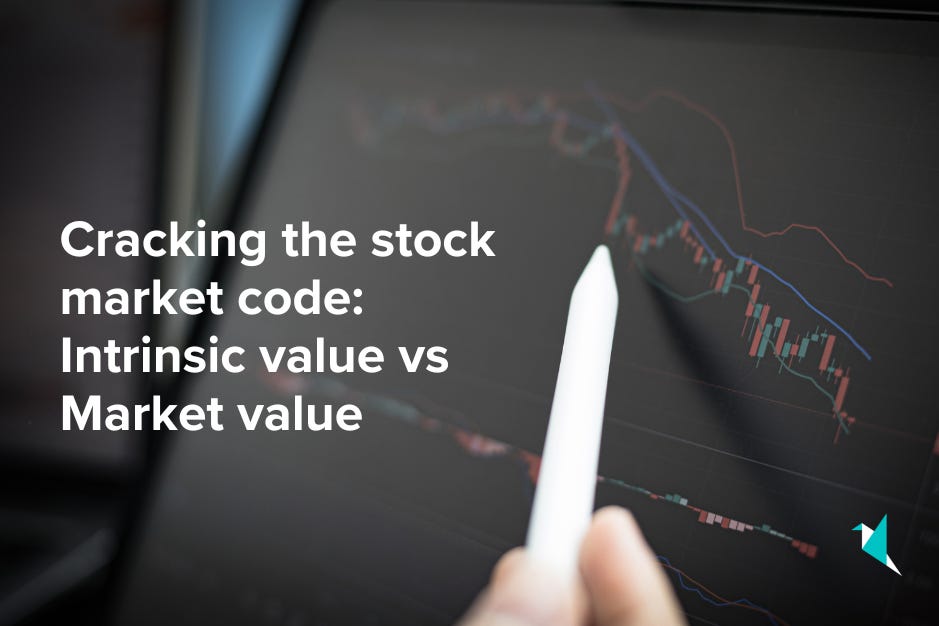Cracking the stock market code: Intrinsic value vs Market value
Have you ever wondered why a company's stock price doesn't always match its "true worth"? Well, that’s where intrinsic value and market value come into play. These two concepts are crucial for anyone looking to make smarter investment decisions. But don’t worry, we’ll keep it simple and relatable. Let’s dive in!
What is market value?🏷️
Market value is like the price tag on a product at the store. It’s what buyers are currently willing to pay and what sellers are willing to accept for a stock. It’s based on real-time demand and supply in the stock market.
Think of it like this: Imagine there’s a sneaker everyone wants (thanks to a celebrity endorsement). The original price was ₹5,000, but now people are reselling it for ₹10,000 because demand is through the roof. That ₹10,000 is the Market Value — it’s driven by demand, hype, and sentiment.
Factors that influence market value🎢
Investor sentiment: If investors feel optimistic, prices go up. If there’s panic (like during a recession), prices drop.
Market news & events: Earnings reports, product launches, or regulatory changes can move stock prices quickly.
Supply and demand: The classic principle. If everyone wants a stock, its market value rises.
Key takeaway
Market Value is what you see on your trading app. It’s the price at which stocks are bought and sold, and it changes every second.
What is intrinsic value?🧮
If the market value is the "price tag," then the intrinsic value is the true worth of the product. It’s what the item is actually worth, regardless of the current hype or popularity.
Think of it like this: Imagine you’re at an auction bidding on a painting. Everyone’s shouting higher bids, and the final price soars to ₹10 lakh. But you know the artist’s past works are typically valued at only ₹5 lakh. In this case, ₹5 lakh is the Intrinsic Value — the "real" value you’d expect the painting to hold.
How is intrinsic value calculated?🤔
Calculating intrinsic value is a bit like detective work. It requires analyzing a company’s fundamentals to figure out its actual worth. Here’s what analysts typically look at:
Cash flows: The money the company is expected to generate in the future.
Growth potential: Will the company's revenue grow or stay flat?
Discount rate: Basically, what future cash is worth in today's money.
There’s no single method to calculate Intrinsic Value. Analysts use models like Discounted Cash Flow (DCF), Earnings Multiples, and Asset Valuation.
Key takeaway
Intrinsic Value is what you’d call the "fair value" of a stock. It’s based on hard data, not market emotions or hype.
The showdown: Intrinsic vs Market value🥊
Here’s a quick breakdown of the differences:
Bottom line: Intrinsic value is steady and data-driven. Market value is volatile and sentiment-driven.
Why does this matter to investors?🎯
If you’re an investor, you want to buy low and sell high. To do that, you need to know when the market value is below the intrinsic value.
Here’s a simple game plan:
Undervalued stocks: If market value < intrinsic value, you’ve got a bargain. It’s like buying a ₹10,000 sneaker for ₹5,000.
Overvalued stocks: If market value > intrinsic value, caution is advised. It’s like paying ₹20,000 for a pair of sneakers that’s actually worth ₹5,000.
This strategy is called value investing and is popularised by legends like Warren Buffett. The goal is to find companies that are "undervalued" by the market but have solid long-term growth potential.
Understanding the difference between these two values also helps avoid emotional decision-making. When stock prices drop due to negative sentiment (like during a market crash), it’s easy to panic and sell. But if you know the company’s Intrinsic Value hasn’t changed, you’ll recognize the opportunity to buy more shares at a discount.
Additionally, identifying when Market Value is significantly higher than Intrinsic Value can help you avoid buying into bubbles. This prevents situations where you buy at inflated prices only to watch them fall later.
Lastly, this knowledge gives you an edge over other investors who might be chasing short-term market trends. By focusing on Intrinsic Value, you’re playing the long game — and long-term investors tend to win.
Spotting diamonds in the rough: Is a stock over or undervalued?🔍
There’s no magic formula, but here’s a quick checklist:
Check the P/E ratio: Compare the stock's price-to-earnings ratio to its industry average. A higher P/E might indicate overvaluation, while a lower P/E could suggest undervaluation. For example, if the average P/E for tech stocks is 20, and a particular tech stock has a P/E of 40, it might be overvalued.
Analyze growth rates: Look at the company's sales and earnings growth. A stock with a high P/E might still be undervalued if it has strong growth prospects. The PEG ratio (P/E divided by growth rate) can be useful here. A PEG below 1 often suggests undervaluation
Compare market value vs intrinsic value: If the stock’s trading price is significantly below its intrinsic value, it might be undervalued.
If this feels like too much math, don’t worry. Tools like stock screeners and investment platforms can do the heavy lifting for you.
Real-world example: Microsoft Corporation💼
Let's consider Microsoft Corporation (NASDAQ: MSFT) as an example. According to recent analysis, Microsoft's estimated intrinsic value is approximately $573 per share. However, the current market price is around $428, suggesting that Microsoft might be undervalued by about 25%
This situation presents an interesting opportunity for investors. If the market eventually recognizes Microsoft's true value, the stock price could potentially rise to match its intrinsic value.
However, it's important to note that other factors, such as market sentiment, company performance, and broader economic conditions, can also influence the stock price. Investors should always conduct thorough research and consider multiple factors before making investment decisions
Your investing compass🎓
Understanding intrinsic and market value is like having a compass in the wild world of investing. It helps you navigate through market hype, spot potential bargains, and avoid overpriced traps.
But remember, these concepts are tools, not crystal balls. The stock market is influenced by countless factors, from global events to investor psychology. So, use this knowledge as part of your broader investment strategy. Combine it with thorough research, diversification, and a clear understanding of your financial goals and risk tolerance.
By balancing data-driven analysis with a holistic view of the market, you'll be better equipped to make informed decisions and navigate the exciting, sometimes turbulent waters of investing.
Disclaimer: All content provided by Winvesta India Technologies Ltd. is for informational and educational purposes only and is not meant to represent trade or investment recommendations. Remember, your capital is at risk. Terms & Conditions apply.









